- Pre NSR
- MC16
- MC18-I
- MC18-II
- MC21
- MC28
1982~1984 MVX250F
The roots of the NSR250 can be traced all the way back to the MVX250!
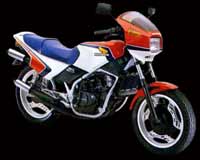
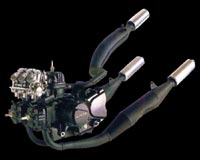
The 3 cylinder MVX, and its single cylinder baby sister, the MBX125F, were Honda's first real attempt to capture the 2-stroke road bike market way back in the early 80's.
The MVX250F was released on February 1st 1983. It's chassis was extremely similar in design to the VT250 4-stroke V-twin, complete with the same "in-board" disc brakes. Although many people still associate the MVX's V3 engine with that of the NS400R, there are no common parts between them, and only the configuration and the use of Honda's ATAC (Automatically-controlled Torque Amplification Chamber), an early power-valve system, link the two models.

The ATAC and HERP system worked by effectively lengthening or shortening the exhaust's tuned length to optimise the reverse pressure waves at the exhaust port. With the valve open and thereby forcing any escaping mixture back into the cylinder. The MVX250 was available in 1983 and 1984, as a Japanese market only model, but the MBX125 was shipped to Europe where, although not as popular as Yamaha's RD series, still sold extremely well. All MVX, MBX, and trail bike engined MTX (125 & 200 single cylinder versions) used cast iron bores.
1985 NS250R MC11
The NS250R MC11 was introduced in 1985 and was the leading edge design destined to be the ultimate configuration for a twin cylinder 2-stroke motorcycle!
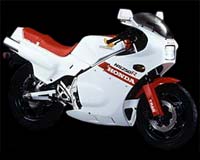
It sported both an aluminium frame and swingarm, unheard of on a road-bike in it's day, along with Honda's trendy Astralight wheels. Again Honda used the ATAC system similar to the MVX, but had now introduced a nickel-silicone carbide (Nikasil) coating on the cylinders for reduced friction and greater wear resistance. 45hp @ 9500rpm out of the showroom made the NS250 an instant hit with Japanese sport riders and club racers alike!It's design and styling was taken directly from the works RS250R's of that era, a bike that was cleaning up in GP's and eventually allowed Freddie Spencer to win both the 250 and 500 World GP titles in the same season!A naked (unfaired) version designated the NS250F was also available. It came without the Astralight wheels or alloy swingarm. It was never as popular as the NS250R, and today is extremely rare!
NSR250R
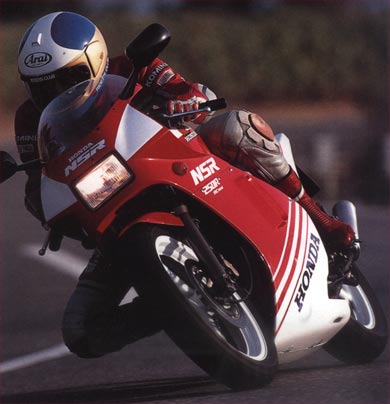
Strongly styled after the consecutive GP250 championship winning RS250RF's from 1985 and 1986, there were also a string of technological cues from the GP bikes followed on the new model.
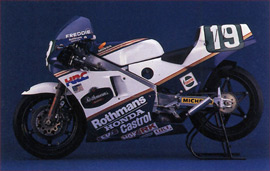
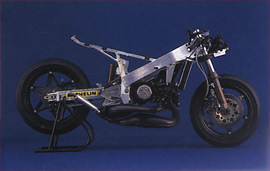
The all-new liquid cooled 90 degree V-twin 249cc motor is now crankcase inducted, unlike the NS250's conventional (for the time) piston ported engine. The "V" configuration is canted forward 20 degrees, lowering the centre of gravity and enhancing manoeuvrability, and is solidly mounted into the twin spar alloy frame just as the GP bikes.
1. New alloy twin spar frame. Increased stiffness, light weight, and compact design inspired by GP250.
2. The pioneering new intake system now allows the Keihin TA series flat-slide carburettors to sit parallel to the top-rear of the cylinders and feed directly into the crankcase. This Honda patented design helps create an extremely compact layout.
New cassette type transmission can be quickly serviced or exchanged without removal of the engine, just as the GP bikes. Utilising a "claw type" shifter mechanism results in fewer moving parts and a smoother operation. The new transmission also benefits from an integrated oil pump allowing for reduced oil quantity and thereby contributing to a lower "wet" weight. This arrangement also produces less drag, and contributes towards greater power transfer.
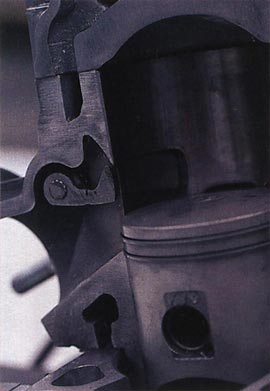
The Nikosil plated all-aluminium cylinders feature the new electronically controlled variable (Revolutionary Controlled) RC Valves.
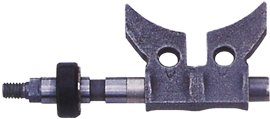
These replace Honda's previous ATAC system as used on the MVX and NS models, and are considerably more efficient. Unlinke the ATAC system, the RC Valves are now employed in both cylinders leading to even greater effectiveness.
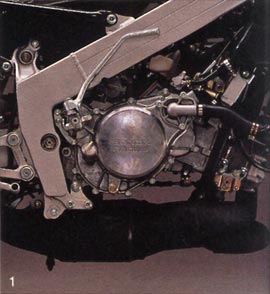
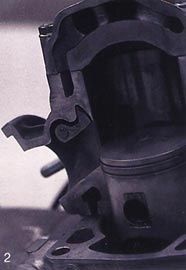
1. MC16E engine cases share the same DNA as the '87 RS250R. 90° V2 crankcase reed valve induction.
2. RC Valve open, increasing exhaust port timing and boosting high RPM output..
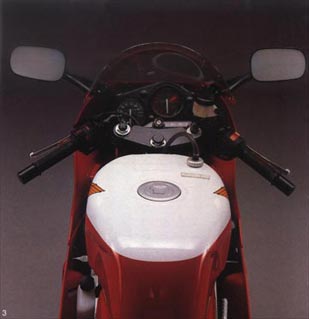
1. Updated sleaker windshield and aerodynamic mirrors.
2. Aggressive styling base on the GP250 and GP500.
3. Instruments dominated by the large tacho.
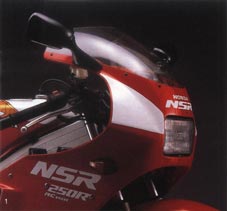
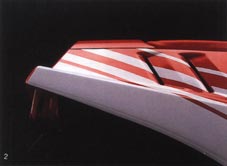
The MC16 was Honda's bid to compete with Yamaha's recently introduced TZR250, and at the time, it's new 3-spoke alloy wheels, heavy duty box-section frame and swingarm, and racy styling made the TZR look comparatively conservative! Although it made the same power as the MC11 due to Japan's licensing laws, it weighed some 20Kg less, and utilised the radical new RC Valve variable height exhaust power valve system, making it an extremely agile but flexible bike for its time! Although only ever a JDM (Japanese Domestic Market) machine, the motor once delimited was quite capable of making 55hp, easily making it competitive with the RG250, KR250, and TZR250, and in full race TT-Formula 3 trim was capable of almost 70hp!
NSR250R
Sharing no common parts with the MC16, the MC18 was another huge leap forwards in 250 design. Everything from the ground up was refinded; from the wheels to the sleak bodywork, from the ignition system to the exhaust system!
The model is often referred to as the "MC18 PGM-I" (PGM one).
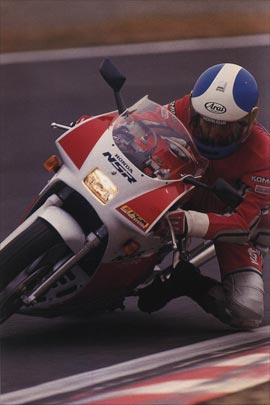
The MC18 R2J employed the world's first computer-controlled 2-stoke carburetion system on a street bike. The system utilises Honda's PGM-CDI to map signals from a throttle position sensor (T.P.S) and RPM to adjust the air correction circuit. An auxiliary control unit adjusts the RC Valve position and speed depending on TPS movement and RPM. The combined systems create a tremendously flexible riding experience, despite the substantially higher state of tune compared to the previous MC16 model.
MC 18 chassis sports 6-spoke Enkie alloy wheels (3" front/4" rear) and new stiffer pentagonal section frame with detachable subframe.
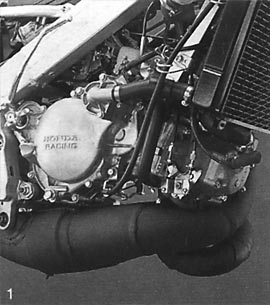
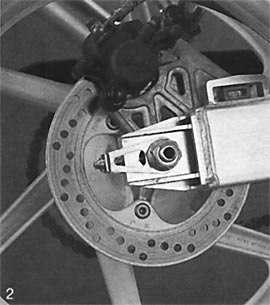
1. The new MC18 motor sees the carburettor venturi size increased from 28mm to 32mm. The compression on the 1988 engine is increased, as is the exhaust port area. While still limited to 45hp to comply with Japan's licensing law, the MC18 R2J (and the later SP) is the simplest of the NSR's to delimit, with around 63hp easily available.
2. 220mm rear disk with smaller lighter single-piston caliper, and 4" wide Enkie 6-spoke alloy wheel.
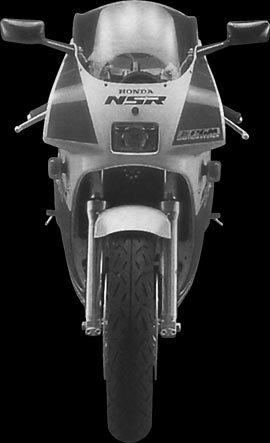
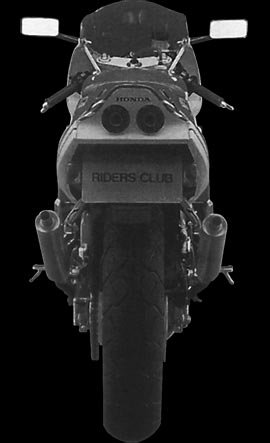
It's racer silhouette, higher swept pipes, and the now familiar 6 spoke Enkei alloy wheels, combine with the almost token gesture of a headlight and mirrors to make it a real racer for the highway! The bike was capable of winning races almost "out of the box", producing in excess of 60hp in standard form with the simplest delimiting modification!
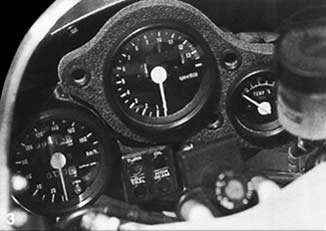
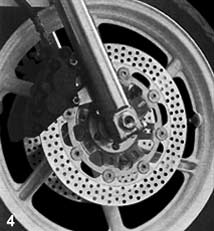
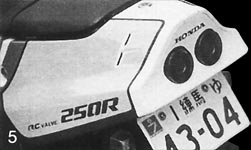
3. Instrument cluster is dominated by the large tacho. Speedo unit and warning light cluster are detachable for racing.
4. 276mm front discs with 4-piston Nissin calipers.
5. Tail unit with twin round lights.
Again the MC18 was available in red and white or blue and white for the first 3 months, before it was joined by a limited edition Rothmans coloured SP edition, the MC18 R4J. Although it was designated an SP, the only real difference between this model and the earlier versions were it's Magtek magnesium wheels and race replica paint.
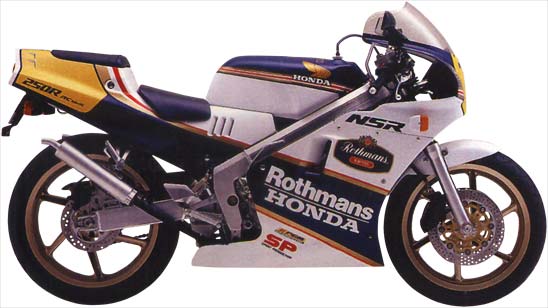
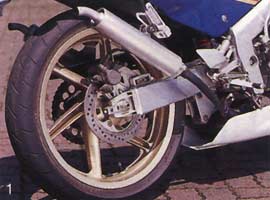
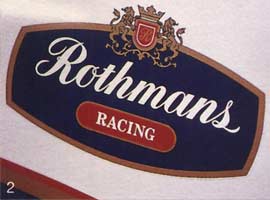
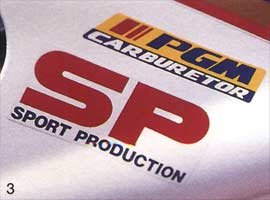
1. NSR250SP R4J now runs on Magtek magnesium alloy wheels.
2. Rothmans colour scheme inspired by the 1988 Works Grands Prix 500.
3. NSR250SP - Sport Production.
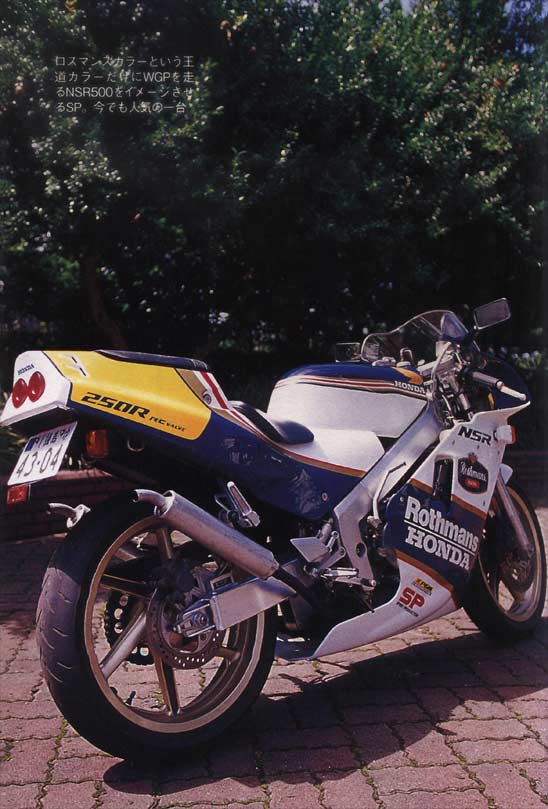
NSR250R
The new model was designated MC18 R5K.
23,000 bikes were projected to be manufactured, and were priced at ¥599,000 for mainland sales.
The R5K models are easily identifiable mechanically by their high swept silencers, the stainless steel rear pipe from the expansion chambers to the silencers, and the torque are from the frame to the rear brake caliper mount.
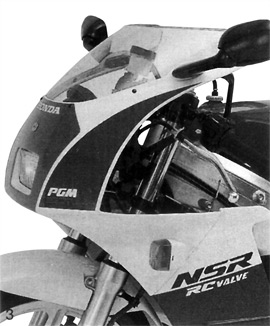
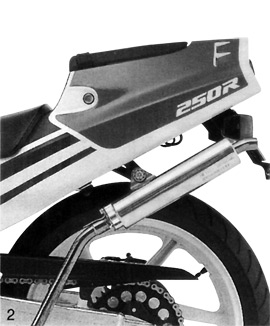
The fairing sports a sleeker more aerodynamic windshield, with a less recessed headlight than the 1988 model. They also had 4 large holes in the belly pan instead of the multi slotted panel like the earlier bikes, and a slightly more sculptured seat unit.
For the first time the range was released in 3 colour schemes; the obligatory red & white and blue & white, but also a new black, red and silver-grey based on the colours of the successful SEED Racing team.
The differences were more than cosmetic however... under the seat unit, away from prying eyes, the first of the "new generation" 3D PGM's was installed. This ignition unit was identical in appearance to the RS250's PGM-II but with an ignition map more suited for increased reliability and road orientated performance.
The PGM-II was incredibly sophisticated for its time, and kept the NSR at the cutting edge of the highly competitive Japanese 2-stroke sportsbike market. The single unit now controls carburetion management, igntion timing, and integrated RC Valve operaion.
PGM-II Carburettor:
Measuring engine speed and throttle position, the PGM-II opens and closes a newer, more sophisticated twin-solenoid air correction circuit, making the fuel system significantly more efficient than that of the previous models.
PGM-II Ignition:
The control unit senses engine speed, throttle position, and throttle opening speed and adjusts the ignition timing to suit, based on pre-programmed maps. Two separate maps are utilised, one for each cylinder, for increased flexibility and accuracy.
PGM-II RC Valve:
The RC Valve timing also gets an overhaul, and now not only responds to engine speed, but also throttle opening and the speed at which it is opened.
The frame is similar to the pentagonal-section unit of the 1988 model, but now sports a swingarm made from similar extrusions in a quest for increased rigidity. A torque-arm is also employed between the frame and the rear caliper mounting bracket to reduce the effect of heavy braking on the suspension geometry. The R5K's were the first model to be fitted with a new 150 section Bridgestone rear tyre, mounted on a 4.5" rim. There was still no multi-way adjustable suspension, although a rear shock, c/w ride height adjuster, was available as an HRC TT-F3 option.
No R5K SP's were released so there were still no dry clutch models, but the whole range benefited from an updated closer ratio gearbox. First gear remained the same, but the following 5 gears were closer. The rear sprocket size was increased from 41T to 42T, giving the stock bike more punch when accelerating, but the resulting final drive and closer ratios lowered the effective top speed a little, but as the NSRs were speed limited to 180kph (112mph) anyway, it wasn't of prime concern.
NSR250SP R6K
On March 3rd 1989, the NSR250R-SP MC18 R6K was announced. The R6K was the first true NSR250 SP model. Sporting a white and silver livery based on the Ajinomoto Terra Racing team's design, it shared the similar gold Magtek magnesium wheels to the previous "Rothmans" MC18R4J, but now with a 4.5" rear and 150/60x18 tyre.
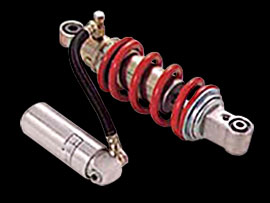
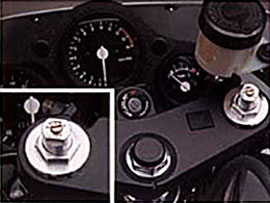
The suspension was adjustable for spring preload and rebound dampening on the front, and spring preload, rebound, and compression dampening on the rear. The rear shock also employed a remote reservoir bolted to a bracket on the subframe undertray, under the seat. The new "Terra" SP was the first model to come complete with the multi-way adjustable rear shock and the now infamous dry clutch.
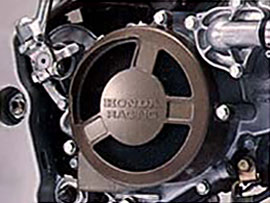
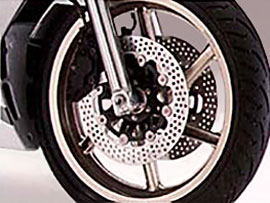
The all new dry clutch was based on the NSR250 and RS250 Grands Prix race bikes, although shares no common components. The dry clutch facilitated quick changes of the consumable clutch parts without the need to drain transmission oil, and also reduced the overall weight of the motor.
Released to compete with Yamaha's new TZR250 Reverse Cylinder, Suzuki's first RGV250, and Kawasaki's KR1, it was (and still is) an extremely competent road and race bike capable of in excess of 70hp in full race trim!
1990 NSR250R MC21
Unveiled in late 1989 as the new 1990 model, the MC21 took the 2-stroke world by storm, and completely re-wrote the rule book on how a 250 2-stroke should be built. The craftsmanship was superb, and the new features were groundbreaking!
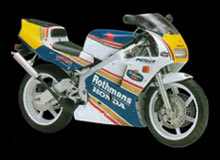
MC21
The MC21 now utilised the PGM-III ECU (also being utilised in GP250 by official HRC factory NSR's). Coupled to throttle position & gear position sensors, the PGM-III controls the timing of the RC Valves, air correctors and ignition advance to give outstanding low end tractability. The PGM-III features a true 3D ignition and a different map for each cylinder.
In keeping with their racer for the road image, the famous Gull-Arm rear swingarm was copied from the factory NSR250 of Luca Cadalora, as was the frame design. Even the mounting point for a steering damper was kept in place! The body-styling was based on the 1989 HRC NSR250, with just a few basic concessions like lights and a rear pillion seat!! The rear wheel diameter was decreased from 18" to 17" and widened to 4.5" to run the latest tyre profiles and compounds.
3 NSR250R colour schemes were released, the usual red & white and blue & white, along with a red and black model, and the R model became Japans best selling 250 2-stroke sports bike. To mark its success in the market and on the track, 2500 SP models were released in 1990, all in the Cabin Racing colours of red, white, silver and gold. Again, like the MC18R6K, they all had the gold Magtek wheels, adjustable suspension, and dry clutch. The MC21 also now featured a closer ratio gearbox with a taller 1st gear and an improved shift mechanism.
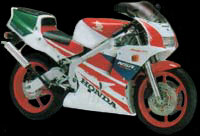
MC21 SE
In 1991 the first SE (Super Edition) was launched, bridging the gap between the R and the SP models. This was basically an SP but with the cheaper standard Enkei alloy wheels, and saved the buyer approximately ¥80,000. The SE's were sold in the Honda Flash (red, white and blue) colours, and 1500 limited edition SP's came in Pentax Racing livery. For 1992 the bike remained unchanged, except for different colour schemes. The SE was now available in white and red, or black and red, and 1500 limited edition Rothmans coloured SP's were released. The R model still remained Japans best selling 2-stroke 250! The only change to the line-up in 1993 was the limited run of 900 Commemorative Edition SP's, easily identifiable by the HRC logo in place of the NSR logo on the fairing. This limited edition was basically an attempt to sell the last of the MC21's before the arrival of the new model!
1994~ NSR250R MC28
In November 1993 the first MC28 went on sale. The styling was only subtly changed, with the seat unit and nose fairing mimicing the factory NSR500 and NSR250 respectively. There was one major styling difference though... the Pro-Arm rear swingarm. This swingarm, originally designed and used on the RC30 for endurance racing, was the last word in styling!
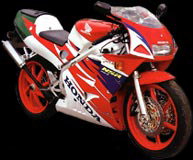
NSR250SE MC28
The MC28 was also the first and only Honda to utilise the PGMIV, activated by the much hyped "Smart Card", a device initially marketed as the ultimate tool in engine management! The idea was to be able to use several different cards, each with their own ignition characteristics, for any given track or weather condition. It was also the first production bike to sport a digital display. In reality however, the PGM-IV only served as a clever restriction aid introduced by Honda to comply with Japans ever increasing clampdown on power output and licensing laws. In fact, the PGM-IV makes the MC28 the costliest and hardest of the NSR's to derestrict.
Although up on weight and down on power, the MC28 still remained the ultimate 2 stroke race-rep', with only Suzuki's 1996 RGV250R VJ23 trying to keep pace with the NSR's ultra high specification.
Throughout its years (1994-1999) the MC28 remained virtually unchanged mechanically, and all three standard models were still available; the R, the SE, and the SP. The 1994 SP was again released in Rothmans colours, with a limited run of 1500 bikes, and in 1995 another 1500 limited edition SP's were released in HRC Racing Colours.
In 1996 the R model was discontinued, and only the SE and SP were sold. Only 1000 SP's were built, and were painted in Repsol colours to commemorate Mick Doohan again winning the World GP championship title.
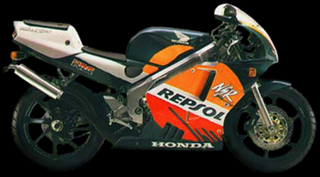
NSR250SP Repsol Special Edition
In 2000 Jha were the only company consistently supporting the NSR250. They bought the majority of remaining bikes and would sell them in any guise from stock to full race, including ram-air, light weight race bodywork, and titanium expansion chambers.
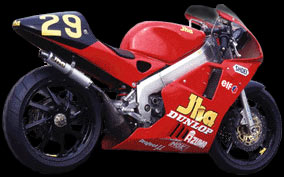
Sadly, in 2001 after correspondence with Jha, we were informed that there was no longer a stock of "new" bikes at their workshops, and although still supplying a wide range of spares and performance products, complete machines were no longer available, and in 2007 Jha eventually ceased trading.
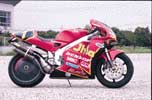
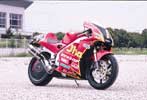
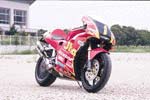

Special thanks to Jha for the updated pictures of their race bike and their continued support over the years. Jha have now sadly ceased trading, which is a crying shame not only for the NSR owner, but for anyone competitively running a competition 2-stroke road/road-race bike, as their products were simply unrivalled in the marketplace and on the circuit.